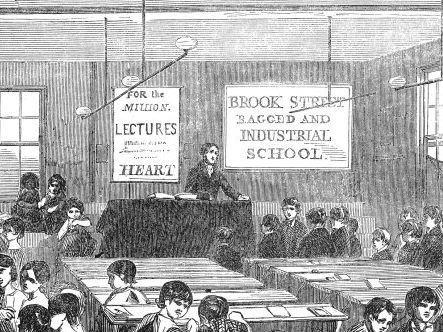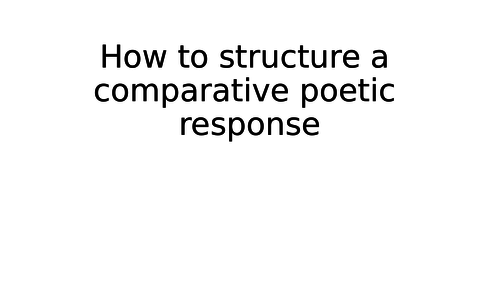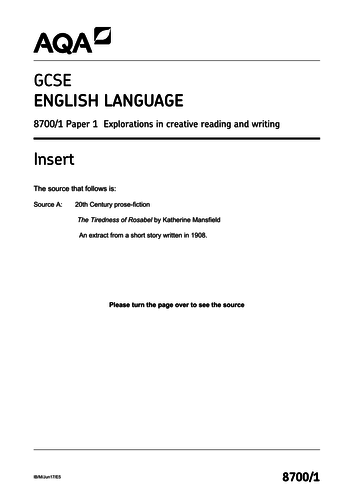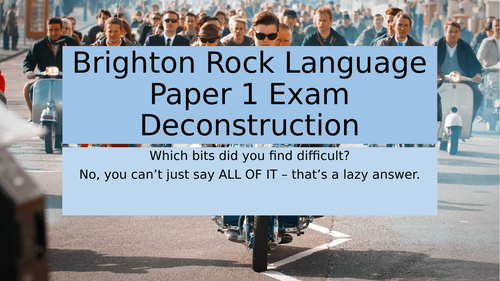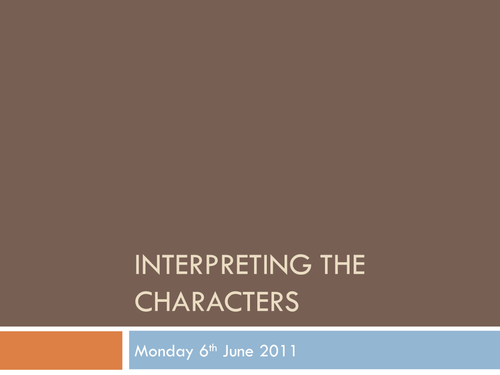
236Uploads
547k+Views
1359k+Downloads
English language arts
Sale

KS3 Northern Lights Complete Unit of Work (Focus on creative writing)
Numerous lessons (though as you’ll see they can be expanded/contracted as meets your need) surrounding the teaching of Phillip Pullman’s Northern Lights (a quite awesome book) to a Key Stage 3 class. I taught this unit to a top and bottom set and got a lot out of it in terms of enjoyment and successful creative writing.
I will be using it as a starting point for a reading assignment with very little modification.
May your daemon guide you well.
ADDITION: I have adapted the material to be more focused on GCSE Language creative skills, and incorporated material drawn from the BBC series His Dark Materials. The “newer” lessons are aimed for higher ability students and deal with some more specific creative writing issues like dialogue.
Sale

AQA English Language Paper 2 Deconstruction: The Other Side of the Dale vs The Ragged School
I’ve done quite a few of these now, and I always try to improve on the last one. I think this is about as far as I can go with this format. Here’s what you get:
An individual breakdown of each of the exam questions. Each section contains the following:
A breakdown of the AQA related material
A walk-through for Q2, Q3 and Q4
Suggested targets and strategies
5 Case studies using real student responses (Except for Q1. You’ve got 10 for Q5 though)
Real students planning processes laid out for discussion
It’s a big one - you’ve got 60+ slides to work through. In terms of teaching, this works best after you’ve sat the relevant exam. However, it wouldn’t take much tweaking for a mock-style scenario. Also, this is designed to be given to the students so that they can engage with it at home.
Sale

AQA English Language Paper 1 Deconstruction: The Silent Land
Similar to a number of other resources I’ve already posted.
Designed to be used after the students have sat the associated AQA English Language Paper 1 GCSE Paper, though with a little tinkering, you could run this as a mock exam itself and then have the students peer/self-assess afterwards.
The powerpoint goes through each of the five questions, placing a firm expectation on the students having a pre-established strategy for completing each task. The students are then encouraged to refine this strategy. Each of the sections contains a break down of the associated source, exploration of the stepped Model Responses provided by AQA, and then provides the students with up to FIVE Case Study responses written by students (containing mistakes and all).
I’ve had a lot of success with these types of powerpoints and they are especially useful for students working in isolation, or as a revision tool.
Hopefully this will be of use to you.
Sale

AQA A-Level English Language and Literature - Introduction to Poetry (Heaney)
My introduction unit for A-Level Language and Literature. It assumes that the academic voices of the students needs sharpening somewhat. I source a lot of stuff from various corners of the net and use it in the power points - pay particular attention to the notes element of the power points by the way. I also include a “model essay” the purpose of which is to get the students to move away from their formulaic essay structures that they have used in their GCSEs.
Think of this as a starting point that may need a little shaping to suit the needs of your class.
Sale

KS3 and KS4: Exploring Dystopian Fiction Creative Writing Unit
I am very pleased with this. We have a problem with retention of English students at A-Level at our place - the English GCSE is just VERY boring. So, part of the plan to address this is to make the sorts of lessons that kids will remember in Key Stage 3; make them fall in love with the subject so to speak.
This is my best efforts at doing just that.
The first lesson covers the basics of Dystopian Fiction - you will need some Dystopian Fiction extracts for this. I picked from the following texts:
The Hunger Games
Maze Runner
Do Androids Dream of Electric Sheep
The Handmaid’s Tale
Ready Player One
1984
Battle Royale
I cannot sell the resource if I put the extracts up on here, but finding your own examples shouldn’t be too tough. But, I did find a free version of the Hunger Games Chapter 1 at the following link:
http://www.scholastic.com/thehungergames/media/hungergames-chapter1.pdf
The second lesson (lessons really) focuses purely on the first chapter of The Hunger Games. Here, we analyse and explore the text before giving the students the chance to write creatively.
The last lessons in the largest power point are a lot of fun. Essentially, the lessons require the students to write a series of mission logs as they flee from a devastated earth, only to be forced to return. There are two versions: one with no music and one with LOADS of atmospheric music attached.
Both powerpoints have a load of set-up animations which run automatically. I advise you go through the powerpoint several times before putting it in front of the kids. And when you do, make sure you have the volume up.
This is one of those lessons they won’t forget in a hurry, I promise.
ADDITION: So I tried this with my Year 10s. They loved it too…
ANOTHER ADDITION: I’ve chucked a debate boxing lesson on the end - it assumes a lot of knowledge of The Hunger Games (shouldn’t be a problem with the films).
Sale

KS3: Fantasy Creative Writing SoW: The Escape from Kraznir 2 - The Return to Kraznir
I had such a lot of sun creating this unit!
In an effort to get students to reflect back on previous work, this unit is set in the same universe as a previous unit called “Escape from Kraznir”, but a point 30 years or so later. Over the course of the unit, the students will write various parts of a story from a variety of perspectives, in a number of tenses and using a range of different forms (all with the AQA English Language P1 Q5 and P2 Q5 in mind). They’ll create characters and be encouraged to focus on exploring the relationships between these characters. Additionally, part of the scheme encourages the students to creatively explore issues surrounding discrimination. This is a big story, with an emphasis on developing creative stamina.
There is a real focus on students justifying their structural choices. This is, in part, a way to prepare the students for AQA English Language P1 Q3 - before the students can comfortably identify and comment on structural choices in the work of other writers, they can develop their ability to do so with their OWN creative writing here.
I’ve incorporated a huge amount of different supporting extracts - not all of which need necessarily be used to progress - and I’ve had a lot of fun creating my own example of how to do it (it’s entirely derivative, but as I encourage students to take inspiration from a variety of sources, it bothers me not).
I include all of the extracts here and was able to find each and every one online for free.
Additionally, there is a homework booklet too.
Finally, I embed a number of sound effects from a website called Zapsplat. Here’s a link to their site should you wish to use any of the samples:
https://www.zapsplat.com/
It would be great to get some feedback for this - so let me know what you think!
PS - if you’re interested in the original unit of work, here’s the link:
https://www.tes.com/teaching-resource/ks3-escape-from-kraznir-creative-writing-pack-my-version-11741179
Sale

AQA English Language Paper 2: Death Zone vs London Snow
A powerpoint lesson designed to be taught either AFTER a class has sat AQA English Language Specimen Paper 4, or to be used WHILST a class is sitting the same paper in the form of a mock exam where feedback is given immediately.
In this powerpoint, I refer directly to the model material provided by AQA and provide some feedback that can be given to the students. The idea with the feedback is that the person marking (teacher or student) writes down the letter/number and, when the marked work is returned, the owner of the response can either write the target down in full or highlight it in a printed version.
Sale

AQA English Language and Literature: Developing Essay Writing Skills for the Heaney section
I used a similar approach with the Paris Anthology section and my class found it to be very useful. The issue they were having focused on incorporating enough AO1 terminology appropriately. This lesson is designed to talk them through an approach to an essay question, starting with the poetic voice, moving on to selecting relevant areas and then placing each level of language as a different starting point before exploring ideas across the language levels. It seemed to work…
Hope others find this useful as a starting point.
Sale

KS3: Woman In Black: Creative Writing focus
Taught as part of a two teacher approach to a top set year 9 class. I focused on developing creative writing skills, with a particular emphasis on the structural components, whilst my partner teacher focused on the more traditional literature style approach.
The Woman In Black was used as the stimulus for all elements of this unit and the climax is a GCSE English Language Paper 1 style task (not included in this pack as it is part of my school’s assessment pack).
Overall, I found this unit to be really useful in challenging students to think about their creative writing in more than just a reactionary way. The nature of the structure focused questions align with my belief that it is always better to teach the Language Paper 1 Q3 question in the form of a structure-focused creative writing commentary at KS3 level. Hopefully this will provide you with a useful starting point for your own creative writing journey.
Sale

AQA English Language Paper 1: The Mill
A PowerPoint designed to be used after students have sat the Section A of the AQA English Language Paper 1 for June 2019. It wouldn’t take much altering to be used as a mock exam itself. The slides are set up to show the model answers from the mark scheme so that students can peer/self assess and give actions and feedback.
Sale

AQA English Language Paper 1: The Tiredness of Rosabel exam deconstruction
A lesson designed to be taught AFTER the class has sat a mock exam. However, with very little modifcation this can become a walking-talking mock exam, or a peer/self assessment based lesson.
The powerpoint contains model material and an indicator as to the quality of the model material. My class found this lesson to be very useful.
Additionally, the insert is available for free should you wish to download it for yourself. I include the link below:
https://linwood.bournemouth.sch.uk/summerwood/files/2017/12/8700_1-INS-EnglishLanguage-G-6Jun17-AM.pdf
Sale

AQA English Language Paper 2 Deconstruction: The Crossing vs. Idle Days in Patagonia
This resource was designed to be used after a class or cohort have sat the 2019 English Language paper 2. It’s set up to be used after a class has sat the exam and had their papers marked, but it wouldn’t take much modification to be used as part of a scenario where the students get the material, execute a preparatory strategy, answer the question and then peer/self mark.
The material from the AQA mark scheme has been integrated into the PowerPoint, so students can get a sense of what level their response is before fine marking. I’ve done a few in this style and the students value them as revision tools too.
Sale

AQA English Language Paper 1: Brighton Rock
A deconstruction of the English Language Paper 1 examination that uses Brighton Rock as a source. I’ve lifted the model material from the mark schemes and there’s FAR related targets included. Essentially, this is a lesson that can be taught either AFTER the students have sat the exam and you want them to peer/self assess, or you could change it so that that they answer a question and then mark their efforts.
The Section B element is a bit of an experiment - peer marking creative writing is always a challenge. So I’ve given the students a series of yes/not/some related questions. The idea is that they “tick” the level next to the answer on a copy of the AO5 and AO6 mark schemes. Using that, they should be better able to work out where the creative writing fits. My peer marked creative writing has got much more accurate as a result of this.
Sale

AQA English Language Paper 2 Section A Resource pack: Jack the Ripper vs Zodiac Killer
A set of resources designed to engage year 11s with English Language Paper 2 Section A. I shaped the lessons around the articles written surrounding the time of Jack the Ripper, and around an article published following the Zodiac Killer sending a letter to the San Fransisco Chronicle.
The class were fascinated by these articles - I had students independently going away and reading pre-19th century newspapers off their own backs! This will need to be taught delicately though - the content is graphic in nature, so be sure that your class has the necessary level of maturity to access this material without being distracted.
Sale

Debate Boxing
This is quite possibly, the coolest thing I've ever tried out. The premise is as follows: a debate between two students (or teams) where four referees observe. The referees score what they see and a winner is announced at the end.
Now add in entrance music a la pro-wrestlers (think the Rocky Theme, We Will Rock You etc.) and run it on an open evening and I promise you this - you will have EVERY parent in at some point to see what is going on.
I've run this at SIX parents evenings now and the same thing happens every time - all of the kids rock up to watch. I set it last time round where the Deputy Head took on the winner of the students (a year 9 girl). They packed the place out to see who won . The debate topic "Batman vs Superman" (serious stuff this). Needless to say, she wiped the floor with him (in a totally professional way).
You'll need to be the promoter/commentator/ring side referee - this can be exhilarating and exhausting!
Try it.
Sale

D6 Dungeons and Dragons: Christmas Mission Pack - THE CASTLE OF TERROR!
PREMISE: You are going to enter the Castle of Terror to save Santa Clause. He has been kidnapped by the evil Necromancer, Alan. His devilish plan is to suck the Xmas spirit out of Santa, and use it to power his horde of undead. He has banded together with the Orcs and Goblins of the nearby Dark Forest. They will protect him whilst he finishes his experiments. You must hurry. The fate of Christmas rests with you…
A mission pack that builds on the free D6 Dungeons and Dragons lesson I created. Print this off (delete the first slide though) for students, or set it up as a power point for the Dungeon Master. All the kids I tried it with loved it. Some of the quotes:
"Voldemorts stolen my nose! Give me back my Magic Dagger!"
"You are the worst re-animated corpse EVER!"
"I use my Staff of Uncertainty to turn you into a Gibbon."
A seriously creative lesson.
Enjoy.
PS - I've also added the initial lesson (Lesson 1) as a starting point for the kids - gets a bit complicated otherwise.

Twelfth Night: Interpreting Characters Powerpoint
A complete powerpoint lesson exploring the way in which students can interpret the characterisation evident in Twelfth Night by William Shakespeare.

Title, Blurb and brief description
A starter activity to get students involved in different types of fiction. You will need to cut out each of the constituent parts, but this is a great starter activity with the kids working together to match them up.

Spelling and Understanding top 100 common words
I teach a very low ability year 7 group and they are missing a large amount of spelling and comprehension knowledge of the simplest words. These work sheets are designed to be printed out back to back, taken home and completed. They will allow you to identify which of your students is able to accurately spell and use these first 100 words. VERY useful for EAL students.


